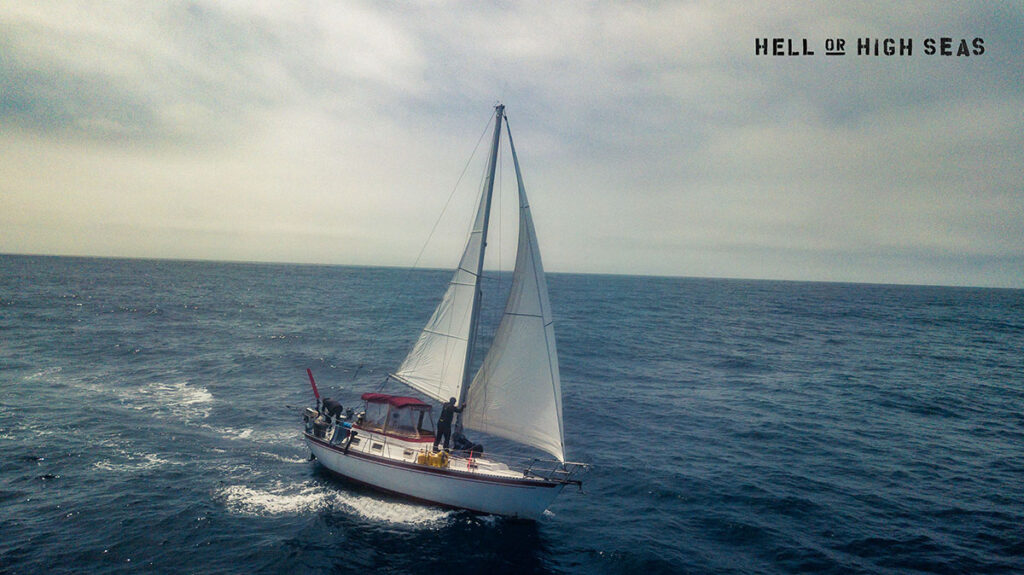
HELL OR HIGH SEAS WILL CHANGE THE WAY WE THINK ABOUT PTSD
One veteran’s battle with PTSD led him—and an intrepid filmmaker—on a dangerous voyage to the edge of the world. Along the way, they proved that everything we think we know about veteran suicide is wrong.
By Matt Tuthill
When you sit down to watch Hell or High Seas, you’re expecting an adventure. The posters, the trailer—everything about the documentary film’s marketing—leads you to believe that you’re about to witness the extreme lengths to which one veteran will go to get his point across. And on that level, it delivers in spades.
The film centers on Taylor Grieger, a former Navy rescue swimmer who found reintegration into civilian life so impossible that he attempted to take his own life. But the round he fired in that suicide attempt, by some miracle, didn’t ignite. Grieger then—doing a real-life impression of Denzel Washington in Man on Fire—takes his new lease on life to attempt a different kind of suicide mission: take a small sailboat with him and his high school friend, filmmaker Stephen O’Shea, from Pensacola, FL around Cape Horn, home of the most notoriously dangerous seas known to man.
Along the way, they sail through a hurricane, the ship’s motor blows out, they’re beset by pirates, and—as difficulties mount—they brawl. At one point, deeming the seas too dangerous, Grieger leaves port without O’Shea, taking on one of the most treacherous legs of the journey by himself.
The singular purpose driving both men: To raise awareness for veteran PTSD and the abysmal veteran suicide rate of 22 servicemen and women who take their own lives every single day. They sail with a Mission 22 flag flying from their ship, all in the hopes that when the film releases, we can learn something through Grieger’s struggles about the crisis facing our veterans.
On that educational level, Hell or High Seas delivers something even bigger than its adventure. It explains PTSD in a way that cuts through the myths and can make anyone understand what the condition really is.
In one of the film’s terrific animated sequences, we see that chronic output of adrenaline—like the kind a veteran would experience during a deployment—shrinks the hippocampus, the region of the brain responsible for helping us regulate our emotions. Meanwhile, the adrenal gland becomes so overactive that it continues to fire at odd times, long after immediate danger has passed.
Grieger describes feeling his fight-or-flight reflex kicking in during the middle of a beautiful day when he wasn’t experiencing anything negative. And when adrenaline floods a system with a beleaguered and shrunken hippocampus, disaster often ensues. The trauma of living a life in which his emotions were on a perpetual runaway train led to the suicide attempt—and ultimately, a voyage around Cape Horn.
It spoils nothing to say you’ll share in their excitement and hope at the beginning, their disappointment and fear when the journey seems doomed, and ultimately, their triumph. That’s what we expect from any movie. But what you don’t always expect—and what I’ll proudly spoil—is the fact that you’ll gain a brand new perspective on what our veterans face—and never think of PTSD and veteran suicide in the same way.
Beyond education, the film also offers a solution to this epidemic: Adventure Therapy. When veterans are outprocessed from the military and able to take on an adventure like sailing—as Grieger does—or climbing or any similarly challenging recreational feat, the fight-or-flight response is mixed in with positive emotions and hormones like oxytocin, which can help change the way veterans process the fight-or-flight response in the future, and even restore a shrunken hippocampus.
In short: The more people who can see this, the better off our veterans will be. Which makes Hell or High Seas more than a good movie. It’s an important one.
Buy or rent Hell or High Seas on VUDU, AppleTV, Google Play, and YouTube. Learn more HERE.


